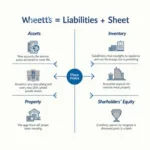Reading Employee Performance Evaluations is a crucial skill for the TOEIC exam. This practice test will help you improve your ability to understand and analyze such documents. Let’s dive into a comprehensive TOEIC Reading Part 1 and 2 practice test focused on employee performance evaluations.
steps for conducting a performance review
Part 1: Incomplete Sentences
-
The annual performance __ is an essential tool for evaluating employee productivity.
A. review
B. revise
C. revision
D. reviewer -
Managers should provide __ feedback to help employees improve their performance.
A. construct
B. constructive
C. construction
D. constructively -
It is important to set __ goals for employees during the evaluation process.
A. measurable
B. measure
C. measurement
D. measuring -
The HR department __ the performance evaluation forms to all managers last week.
A. distributed
B. distribute
C. distributing
D. distribution -
Employees are encouraged to conduct a self-__ before meeting with their supervisor.
A. assess
B. assessing
C. assessment
D. assessed -
The company uses a __ rating system to evaluate employee performance.
A. five-point
B. five-pointed
C. five-pointing
D. five-pointer -
__ reviews help identify areas where employees need additional training.
A. Periodical
B. Periodic
C. Period
D. Periodically -
Managers should __ specific examples when discussing an employee’s performance.
A. cite
B. site
C. sight
D. cited -
The performance evaluation process should be __ and free from bias.
A. object
B. objection
C. objectively
D. objective -
Employees have the right to __ their performance evaluation if they disagree with it.
A. appeal
B. appease
C. appear
D. applaud -
__ communication skills are essential for providing effective feedback during evaluations.
A. Strong
B. Strongly
C. Strength
D. Strengthen -
The company’s performance management system aims to __ employee growth and development.
A. foster
B. fester
C. faster
D. feaster -
Managers should __ both positive aspects and areas for improvement in their evaluations.
A. address
B. adress
C. addres
D. addressing -
Performance evaluations often include a section for setting future __ and objectives.
A. goals
B. golds
C. goats
D. gulls -
It is crucial to maintain __ when discussing sensitive performance issues.
A. confidentially
B. confidential
C. confidentiality
D. confident -
The HR department provides __ to managers on how to conduct effective performance reviews.
A. guidance
B. guide
C. guiding
D. guided -
Employees should be given the opportunity to __ on their own performance during the evaluation.
A. reflect
B. reflection
C. reflective
D. reflecting -
Performance evaluations help identify high-__ employees for potential promotions.
A. perform
B. performer
C. performing
D. performance -
The company’s evaluation process __ both quantitative and qualitative measures of performance.
A. incorporates
B. incorporation
C. incorporate
D. incorporated -
Managers should __ their expectations clearly to employees during the review process.
A. communicate
B. communication
C. communicative
D. communicatively -
Regular feedback sessions can help __ surprises during the annual performance review.
A. minimize
B. minimal
C. minimalize
D. minimized -
The performance evaluation form includes a section for employees to __ their career aspirations.
A. discuss
B. discussion
C. discussed
D. discussing -
It is important to __ performance goals that align with the company’s overall objectives.
A. establish
B. established
C. establishing
D. establishes -
Managers should avoid __ bias when evaluating employee performance.
A. recent
B. recency
C. recently
D. recentness -
The company conducts __ reviews to ensure fair and consistent evaluations across departments.
A. calibration
B. calibrate
C. calibrated
D. calibrating -
Employees are encouraged to __ in their performance review by providing relevant data and examples.
A. participate
B. participation
C. participating
D. participative -
The performance evaluation process should be __ to changes in the business environment.
A. adapt
B. adaption
C. adaptive
D. adaptable -
Managers should provide __ praise for employees who have exceeded expectations.
A. specific
B. specify
C. specificity
D. specifically -
The company’s performance management system aims to __ individual goals with organizational objectives.
A. align
B. alignment
C. aligning
D. aligned -
Performance evaluations can help identify skills __ within the organization.
A. gaps
B. gapped
C. gapping
D. gapless
Part 2: Text Completion
Text 1
Performance evaluations are an essential tool for (31) __ employee growth and development within an organization. These assessments provide a structured (32) __ for managers and employees to discuss job performance, set goals, and identify areas for improvement. A well-designed evaluation process can (33) __ to increased productivity, better communication, and improved employee satisfaction. However, it is crucial that both managers and employees approach the evaluation process with an (34) __ mindset and a willingness to engage in constructive dialogue.
-
A. fostering
B. hindering
C. ignoring
D. delaying -
A. framework
B. obstacle
C. distraction
D. barrier -
A. lead
B. leads
C. leading
D. led -
A. open
B. closed
C. biased
D. negative
Text 2
When conducting performance evaluations, managers should focus on providing (35) __ feedback that is both specific and actionable. This involves (36) __ concrete examples of the employee’s performance and behavior, rather than relying on vague generalizations. It is also important to (37) __ a balance between recognizing achievements and addressing areas that need improvement. By creating a supportive and constructive atmosphere during the evaluation process, managers can help employees feel (38) __ about their professional development and motivated to achieve their goals.
-
A. constructive
B. destructive
C. ambiguous
D. irrelevant -
A. avoiding
B. ignoring
C. providing
D. concealing -
A. strike
B. struck
C. striking
D. stroked -
A. discouraged
B. indifferent
C. anxious
D. empowered
Text 3
Effective performance evaluations require careful (39) __ and preparation from both managers and employees. Managers should review the employee’s job description, previous evaluations, and any relevant performance data before the meeting. Employees, on the other hand, should (40) __ in self-assessment and come prepared with examples of their accomplishments and challenges. During the evaluation, it is essential to maintain a (41) __ and professional tone, even when discussing sensitive issues. After the evaluation, both parties should work together to create a (42) __ plan for addressing any identified areas of improvement.
-
A. negligence
B. planning
C. avoidance
D. procrastination -
A. engage
B. engaged
C. engaging
D. engages -
A. hostile
B. confrontational
C. respectful
D. dismissive -
A. vague
B. concrete
C. unrealistic
D. impossible
Text 4
Organizations can enhance the effectiveness of their performance evaluation process by (43) __ regular training for managers on how to conduct fair and objective assessments. This training should cover topics such as avoiding common biases, providing effective feedback, and setting SMART (Specific, Measurable, Achievable, Relevant, Time-bound) goals. Additionally, companies should (44) __ to gather feedback from employees about the evaluation process itself and make improvements based on this input. By fostering a culture of continuous improvement and open communication, organizations can (45) __ that their performance evaluation system remains relevant and valuable. Ultimately, a well-executed performance evaluation process can contribute significantly to employee engagement, retention, and overall (46) __ success.
-
A. eliminating
B. reducing
C. providing
D. avoiding -
A. refuse
B. hesitate
C. neglect
D. strive -
A. ensure
B. ensured
C. ensuring
D. ensures -
A. organizational
B. organize
C. organizing
D. organized
Answer Key
Part 1: Incomplete Sentences
- A
- B
- A
- A
- C
- A
- B
- A
- D
- A
- A
- A
- A
- A
- C
- A
- A
- C
- A
- A
- A
- A
- A
- B
- A
- A
- D
- A
- A
- A
Part 2: Text Completion
- A
- A
- A
- A
- A
- C
- A
- D
- B
- A
- C
- B
- C
- D
- A
- A
This comprehensive practice test focuses on employee performance evaluations, covering various aspects of the evaluation process, including feedback techniques, goal-setting, and best practices for conducting reviews. By practicing with these questions, you’ll be better prepared to tackle similar topics in the actual TOEIC Reading test. Remember to review the answer key and analyze any mistakes to improve your performance in future practice sessions.




